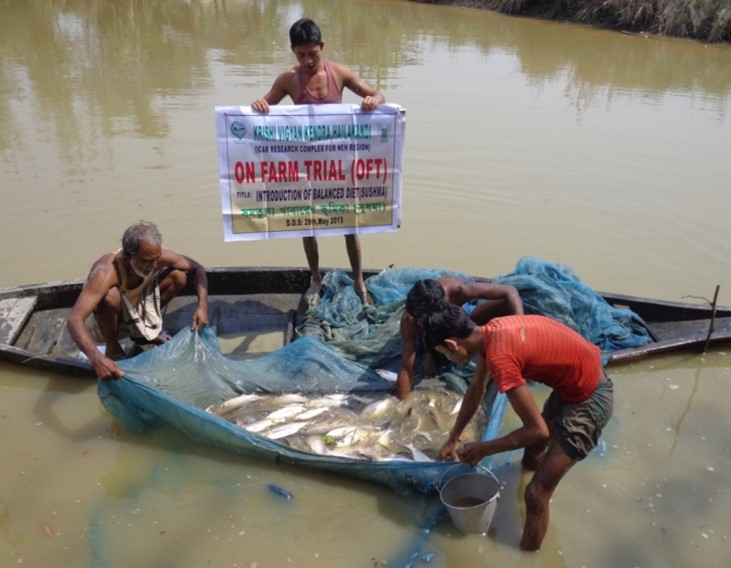Sushma-A balanced diet for carp help increase farmer’s income by three fold
One of the main reasons for the low level of production of fish in the district can be attributed to the lack of availability of formulated feed or balanced diet which yields optimum production from a unit area. Farmers still use the conventional way of feeding the fishes by using only rice bran and mustard oil cake which provide only a certain amount of protein and carbohydrate whereas the fishes are deprive of all the essential vitamins, mineral, fat and other ingredient which will make the fish grow at a faster rate.
About the technology
Sushma a balanced diet formulated and manufactured by Fisheries Research Centre, AAU, Jorhat. It is prepared by without using fish meal in its composition. The fish meal is replace using edible soya bean flakes as protein supplement. In order to demonstrate the importance and the role that balance feed has in increasing the fish production, KVK Hailakandi started taking OFT on Introduction of Balanced diet (Sushma) for carp. This feed was manufacture by Fisheries Research Centre of AAU Jorhat through their experiment and was release in the year 2003.
KVK Intervention
The technology was demonstrated during the year 2012-13 through OFT mode.For demonstration of this technology we have selected 5 ponds with pond size of 0.1 Ha. The entire pond were properly cleaned and liming was done as per recommended dose after which filling of water was then started to make the pond ready for releasing of fingerlings. The depth water is maintained at around 1.5-2 m so that the fishes won’t have to face the heat of the summer if water depth is less. The fishes are then stocking early in the morning after prophylactic bath with Potassium Permanganate solution and stocked @ 5500/ha. The fish seed which we have use for stocking is yearling so that we can achieve the desired result. Production will be better if we can stock with stunted yearling (carried over seed). The best time to stock the fish seed is during the month of April/ May. After stocking the seed the fish are then fed daily with Sushma a feed which we have collected from AAU Jorhat. The rate of feeding is @1-1.5 % of body weight. The fish are fed during the morning and evening hour at the same time interval. Apart from feeding liming is being done at regular interval so as to maintain the pH level of the pond so that there won’t be any changes in the physic chemical parameters of the water. Pond management like regular application of lime (monthly), regular supply of feed, control of algal bloom and aquatic weed are also done regularly
Other facilities like, advices etc. were provided to them through health diagnostic visits, advisory services etc. The farmers feed the fish with Sushma feed provided as part of the trials.KVK monitored the units regularly and provided suggestions and recommendation through training on site selection. Techniques of feeding management, health management etc. were also given to the farmers. Time to time visit to the farmers’ household was done to observe the system of rearing as well as to record data on body weight etc. and overall growth performances of the distributed birds to assess their performance. The various data regarding their productive performance was also collected from the farmer.
Impact of the technology
Md. Tutamia Hazary of VillageSerispore Chandpur West, Hailakandi Block approached KVK Hailakandi and regularly visits the demonstration units which motivated him and put forward his interest in fish culture but has not been able to reap much profit due to many reason.
Before the introduction of the technology the farmer was able to obtain a net profit of Rs 11,500/- for expenditure of Rs 6000/-. Without the intervention the survival rate of the fish was only 75 %.
Economics of the system calculated based on the results of fields trials conducted at 5 location for a 0.1 ha pond for a combination of three species of Indian Major carps, depending on water availability gave a net profit of Rs. 32,900/- for an expenditure of Rs.13, 300/-. The survival rate of the stocked fish was achieved at 95% through adequate water quality management.
Although the use of pelleted feeds and commercially produced feed mixtures is gradually increasing, several farmers continue to prepare on-farm feed mixtures to reduce the cost of production. Farmers recognize the benefits of feeding with balanced feed, particularly with regard to economies in labour and ease of feeding. While farmers appreciate these benefits, a lack of assured supplies of balanced feed is the major constraint at present .The yield of fish obtained by the farmers using balanced feed was consistently higher than that of the farmers using the other feeds.


